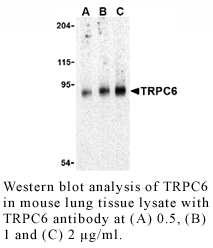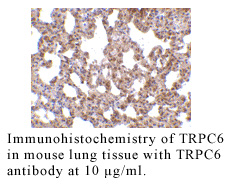Anti-Human Transient Receptor Potential Channel 6 (CT) (TRPC6)
Anti-Human Transient Receptor Potential Channel 6 (CT) (TRPC6)
Product No.: T289
- -
- -
Target Transient Receptor Potential Channel 6 Product Type Polyclonal Antibody Alternate Names Short Transient Receptor Potential Channel 6, Htrp6 Applications IHC FFPE , WB |
Data
- -
- -
Antibody DetailsProduct DetailsReactive Species Human Host Species Rabbit Product Concentration 1.0 mg/ml Formulation This polyclonal antibody is formulated in phosphate buffered saline (PBS) pH 7.4 containing 0.02% sodium azide as a preservative. Storage and Handling This polyclonal antibody is stable for at least one week when stored at 2-8°C. For long term storage, aliquot in working volumes without diluting and store at –20°C in a manual defrost freezer. Avoid Repeated Freeze Thaw Cycles. Country of Origin USA Shipping Next Day Ambient RRIDAB_2831886 Each investigator should determine their own optimal working dilution for specific applications. See directions on lot specific datasheets, as information may periodically change. DescriptionDescriptionSpecificity Rabbit Anti-Human Transient Receptor Potential Channel 6 (TRPC6) recognizes an epitope near the C-terminus of Human, Mouse and Rat TRPC6. This polyclonal antibody was purified using affinity chromatography. Background The mammalian transient receptor potential (TRP) superfamily can be divided into three major families including the “canonical TRP” (TRPC) family. The seven members of this family share the activation through PLC-coupled receptors and have been suggested to be components of receptor-regulated cation channels in different cell types.1 Furthermore, the members of the TRPC6/6/7 subfamily can be activated by diacylglycerol (DAG) analogs, suggesting a possible mechanism of activation of these channels by PLC-coupled receptors. When expressed in transfected cells, TRPC6 acts as a non-selective store-independent receptor-activated cation channel. It is activated by DAG in a PKC-independent manner and is insensitive to IP3 activation. There is increasing evidence that TRPC6 encodes endogenous DAG-activated receptor-operated cation channels in vivo. References & Citations1. Contell, C. et al. (2002) Mol. Cell 9:229 2. Dietrich, A. et al. (2005) Pflugers Arch. 451:72 3. Trebak, M. et al. (2003) Cell Calcium 33:451 Technical ProtocolsCertificate of Analysis |
Related Products
- -
- -




